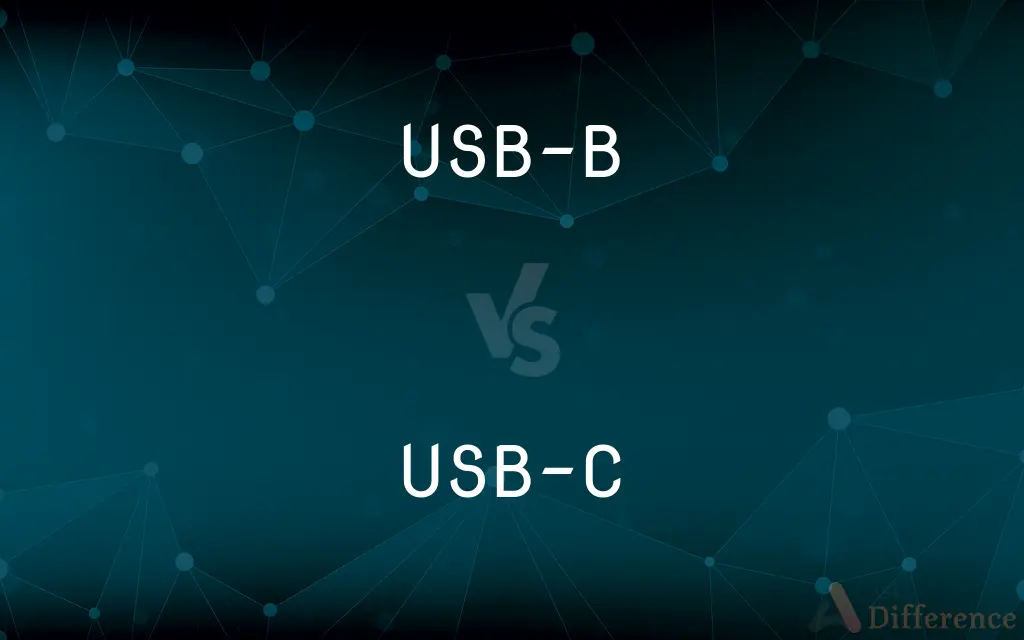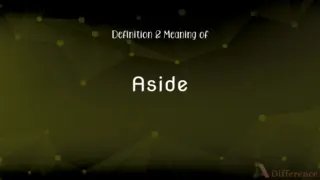USB-B vs. USB-C — What's the Difference?
By Tayyaba Rehman & Urooj Arif — Published on February 1, 2024
USB-B is a square-shaped connector for USB devices, while USB-C is a reversible, compact connector supporting faster data and power transfer.

Difference Between USB-B and USB-C
Table of Contents
ADVERTISEMENT
Key Differences
USB-B connectors are characterized by their square shape and are commonly used in printers and older devices. USB-C connectors, on the other hand, are known for their slim, reversible design, making them more versatile and user-friendly.
While USB-B was standard in many devices, its usage has declined in favor of the more advanced USB-C. USB-C supports faster data transfer rates and power delivery, making it preferable for modern technology.
USB-B's design is less convenient compared to USB-C's reversible plug, which eliminates the issue of plug orientation. The evolution from USB-B to USB-C represents a significant improvement in USB technology, emphasizing ease of use and performance.
The compatibility of USB-B is limited to certain devices, whereas USB-C has been adopted across a wide range of devices, including smartphones, laptops, and tablets. This widespread adoption of USB-C underscores its versatility and efficiency compared to USB-B.
USB-B's role in the USB ecosystem has diminished as USB-C becomes the standard for new devices, highlighting the progression towards more efficient and user-friendly technology. USB-C's ability to handle multiple functions, such as video output and power delivery, further sets it apart from USB-B.
ADVERTISEMENT
Comparison Chart
Shape
Square with one beveled corner
Reversible, oval shape
Data Transfer Speed
Up to 480 Mbps (USB 2.0)
Up to 40 Gbps (USB4)
Power Delivery
Limited to 5V and lower amperage
Up to 20V and higher amperage
Compatibility
Printers, older devices
Smartphones, laptops, newer devices
Orientation
Non-reversible, specific plug orientation
Reversible, any orientation plug-in
Compare with Definitions
USB-B
USB-B connections are primarily used in devices where a compact connection is not critical.
My audio interface uses a USB-B port because it stays stationary on my desk.
USB-C
USB-C is a universal connector standard known for its reversible plug design.
I love that I can plug in my USB-C cable without worrying about which way is up.
USB-B
USB-B is a type of USB connector typically used for connecting printers and external hard drives.
I used a USB-B cable to connect my printer to my computer.
USB-C
USB-C supports a wide range of protocols, including data, power, and video delivery.
With a single USB-C cable, I can charge my laptop, transfer files, and connect to an external display.
USB-B
USB-B cables are characterized by their square shape with one beveled corner.
Make sure you have a USB-B cable; it's the one with the square end.
USB-C
USB-C can deliver power up to 100W, enabling fast charging for compatible devices.
My laptop charges quickly thanks to its USB-C power delivery capabilities.
USB-B
USB-B ports are less common in modern devices, favoring the more versatile USB-C.
My old external hard drive uses a USB-B connection, so I needed an adapter to connect it to my new laptop.
USB-C
The compact and versatile nature of USB-C makes it ideal for modern, slim devices.
My smartphone uses a USB-C port, saving space for other features.
USB-B
The USB-B interface is known for its role in USB 2.0 and USB 3.0 specifications.
This device requires a USB-B 3.0 cable for optimal performance.
USB-C
The adoption of USB-C across various devices facilitates a universal connectivity standard.
It's convenient that both my headphones and laptop use USB-C, so I need only one type of cable.
Common Curiosities
Why is USB-C preferred over USB-B?
USB-C is preferred for its higher data transfer speeds, reversible design, and ability to deliver more power.
What is USB-B?
USB-B is a type of USB connector commonly used in older devices like printers and external hard drives, characterized by its square shape.
Can USB-B and USB-C connectors be used interchangeably?
No, USB-B and USB-C connectors cannot be used interchangeably due to their different shapes and functionalities.
What is USB-C?
USB-C is a newer USB connector standard known for its small, reversible design, supporting high-speed data transfer and power delivery.
What devices use USB-C?
USB-C is used in a wide range of devices, including smartphones, laptops, tablets, and more modern peripherals.
Are USB-B and USB-C connectors backward compatible?
USB-C is designed for backward compatibility with previous USB standards using adapters, but USB-B directly is not.
Is there a difference in the durability of USB-B vs. USB-C connectors?
USB-C connectors are designed to be more durable, with a higher plug/unplug cycle life compared to USB-B.
Are USB-B cables still used?
Yes, USB-B cables are still used for specific devices like printers and older external hard drives.
Is USB-C faster than USB-B?
USB-C can be faster than USB-B, especially in versions that support USB 3.1 or higher, offering significantly higher data transfer rates.
Do I need an adapter to connect a USB-B device to a USB-C port?
Yes, an adapter or a cable with USB-B on one end and USB-C on the other is needed to connect a USB-B device to a USB-C port.
What devices commonly use USB-B?
USB-B is commonly used in printers, some external hard drives, and certain musical equipment.
Can I charge my device faster with USB-C?
Yes, USB-C can charge devices faster due to its support for higher power delivery compared to USB-B.
What is the maximum power delivery of USB-C?
USB-C can deliver up to 100W of power, depending on the specific USB Power Delivery (USB-PD) specification.
Are all USB-C cables the same?
Not all USB-C cables are the same; they vary in terms of data transfer speeds, power delivery capacities, and support for alternate modes.
Can USB-C be used for video output?
Yes, USB-C can carry video signals, such as those conforming to the DisplayPort or HDMI standards, through alternate modes.
Share Your Discovery

Previous Comparison
Super Key vs. Candidate Key
Next Comparison
Separation in Islam vs. Divorce in IslamAuthor Spotlight
Written by
Tayyaba RehmanTayyaba Rehman is a distinguished writer, currently serving as a primary contributor to askdifference.com. As a researcher in semantics and etymology, Tayyaba's passion for the complexity of languages and their distinctions has found a perfect home on the platform. Tayyaba delves into the intricacies of language, distinguishing between commonly confused words and phrases, thereby providing clarity for readers worldwide.
Co-written by
Urooj ArifUrooj is a skilled content writer at Ask Difference, known for her exceptional ability to simplify complex topics into engaging and informative content. With a passion for research and a flair for clear, concise writing, she consistently delivers articles that resonate with our diverse audience.













































